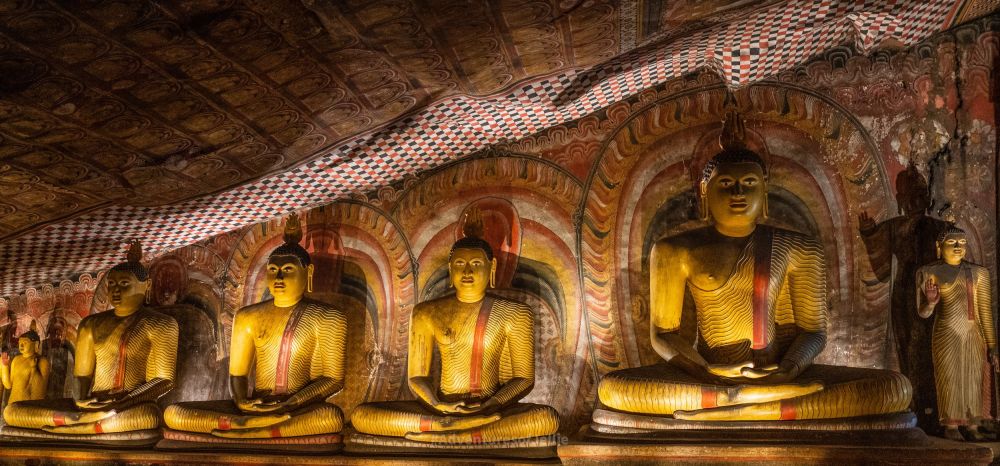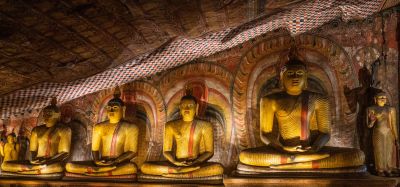

Explore the five main caves of the Dambulla Cave Temple, each filled with ancient Buddhist murals and statues. These caves date back to the 1st century BCE and have been maintained by successive kings. Among the over 150 Buddha statues in these caves, the reclining Buddha in the first cave, Maharaja Viharaya, is notable. Visitors can marvel at the intricate details of the murals covering the cave ceilings and walls, depicting scenes from the Buddha's life and historical events. Listen closely as guides explain the history and significance of each artifact. The cool interior of the caves provides a serene atmosphere for reflection and admiration of ancient Sri Lankan artistry.
Witness the breathtaking sunset from the top of the Dambulla Rock. After a day of exploring the cave temples, make your way to the western side where you can catch the sun dipping below the horizon. The panoramic view is not just limited to the setting sun; the surrounding plains and Sigiriya Rock Fortress in the distance add to the captivating scenery. This peaceful experience allows visitors to appreciate the natural beauty of the region while reflecting on the historical and spiritual significance of the site. It's a perfect moment for photography enthusiasts and nature lovers.
Dambulla Cave Temple also features a museum where visitors can learn more about the temple's history and the region's heritage. The museum offers an array of artifacts, models, and exhibits that provide context to what you see inside the caves. Highlights include detailed explanations of the muratorial work necessary to preserve the cave paintings and statues. Exhibits also track the history of Buddhism in Sri Lanka and the temple's role in it. It’s a great way to gain deeper insight into the cultural and religious significance of the temple complex.
To enhance your visit to the Dambulla Cave Temple, consider a guided tour. Knowledgeable local guides can provide in-depth history and stories behind each cave and its contents. Having an expert guide will enrich your experience as they provide context and answer questions you may have. Tours often include aspects not immediately obvious to the casual observer, such as the significance of certain paintings, the history behind specific statues, and the architectural design of the caves. A guided tour ensures that you leave with a deep understanding of the complex's spiritual and cultural importance.
The Dambulla Cave Temple offers stunning photo opportunities. With its ancient Buddha statues, intricate frescoes, and picturesque views of the surrounding landscape, photography enthusiasts will find plenty to capture. While inside the caves, it is important to respect the sacred nature of the site—flash photography is not allowed as it can damage the ancient paintings. Outside, the golden Buddha statue, the temple's gate, and the panoramic vistas provide unique backdrops for stunning photographs. This activity is ideal for those who want to take home memories in the form of vivid photographs.
The serene and peaceful atmosphere of the Dambulla Cave Temple is perfect for meditation. Visitors can join the monks in meditation or find a quiet corner to practice their own meditation. The caves provide a sanctified space, where the calm and silence enhance one's ability to meditate deeply. Experiencing meditation here allows visitors to connect with the spiritual essence of the temple and follow in the footsteps of countless monks who have meditated here for millennia. It’s also an opportunity to relax and find inner peace amidst a busy travel schedule.
Occasionally, the temple grounds become a stage for traditional Sri Lankan cultural performances. These shows often include Kandyan dancing, drumming, and other forms of local performing arts, providing insight into the rich cultural traditions of the region. The vibrant costumes, energetic dances, and rhythlical drum beats make for an enchanting experience. Check locally for schedules as these events are not daily occurrences and may align with special religious holidays or festivals.
Near the entrance to the temple complex, you'll find stalls selling traditional Sri Lankan crafts, jewelry, textiles, and souvenirs. These shops provide visitors with the opportunity to purchase handcrafted items made by local artisans. It's not just a shopping experience but also a chance to support the local economy and take a piece of Sri Lankan culture home with you. From intricate wood carvings to beautifully woven fabrics, the variety of crafts available serves as a testament to the island's rich artisanal heritage.
For those interested in the religious aspects of the Dambulla Cave Temple, participation in religious observances can be a profound experience. Visitors can observe or join in with the offerings and candle lighting, especially during Poya (full moon) days, which are of special significance in the Buddhist calendar. The Poya days see heightened activity with many local devotees visiting the temple to perform rituals and offer prayers. Whilst participating, it’s crucial to be respectful of the customs and traditions, keeping silent and removing shoes before entering the holy spaces.
No visit to Dambulla is complete without trying some of the local cuisine. Around the temple complex, you'll find several eateries where you can sample traditional Sri Lankan dishes. Try the delectable rice and curry, which may include various vegetable curries, dhal (lentil curry), and spicy sambols. Many places also offer 'kottu roti', a popular street food made by stir-frying chopped flatbread with vegetables and meat or eggs. This activity not only satisfies your hunger but also immerses you in the local flavors and culinary traditions of Sri Lanka.
